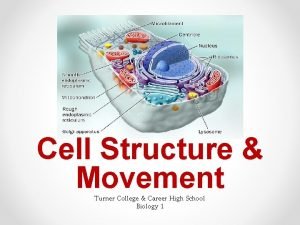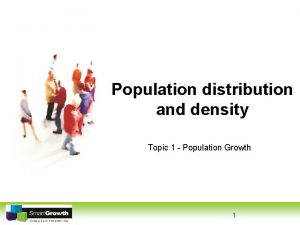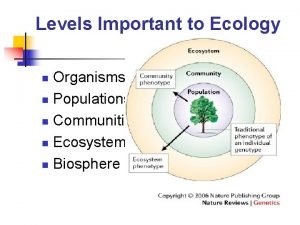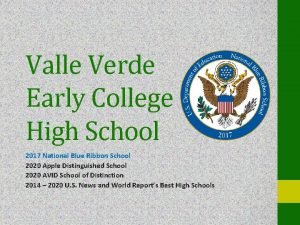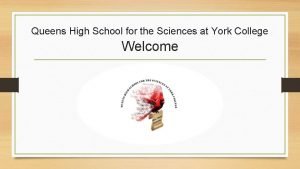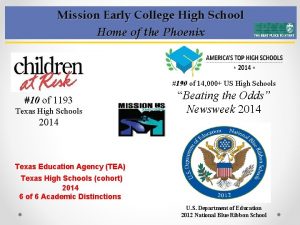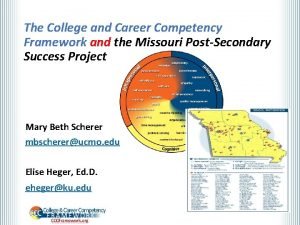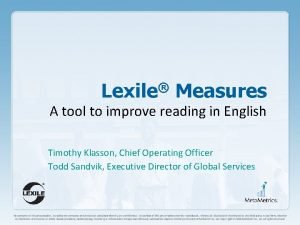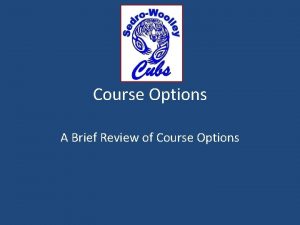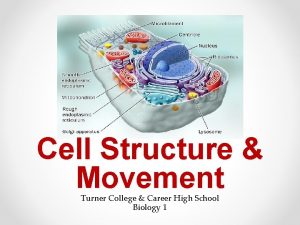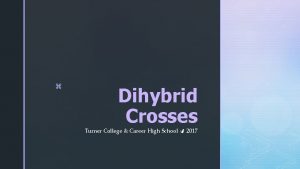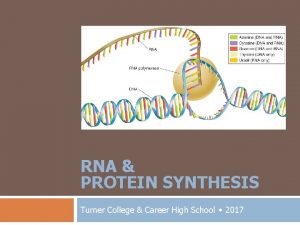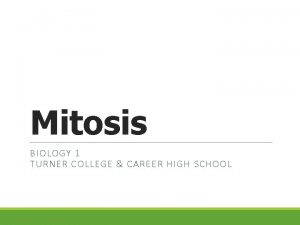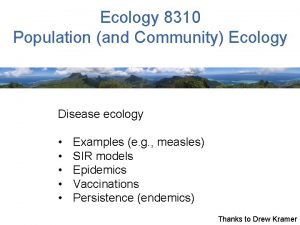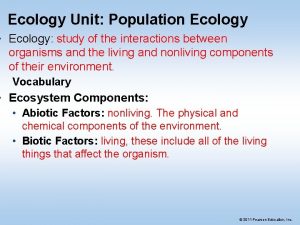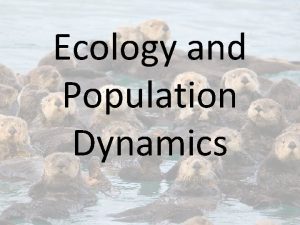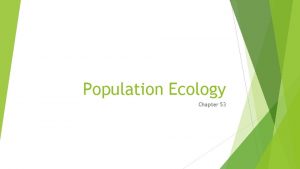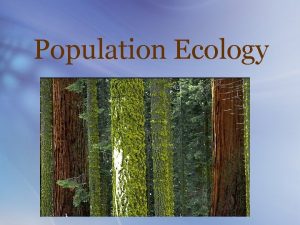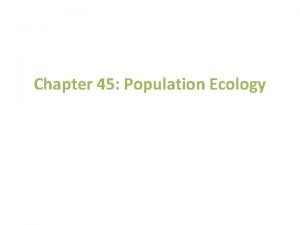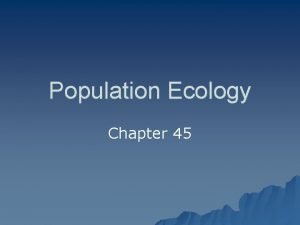Population Ecology Turner College Career High School 2018






















































- Slides: 54

Population Ecology Turner College & Career High School 2018

Populations • A population is a group of individuals of the same species living in an area. • Demography is the statistical study of populations, allows predictions to be made about how a population will change.

Population Dynamics • Three Key Features of Populations – Size: the number of individuals in an area. – Density: measurement of population per unit area or unit volume • Pop. Density = # of individuals ÷ unit of space – Distribution: dispersal in a variety of ways that are influenced by environmental and social factors.

Key Features of Populations Growth Rate: – Birth Rate (natality) - Death Rate (mortality) – How many individuals are born vs. how many die – Birth rate (b) − death rate (d) = rate of natural increase (r)

Growth Rate

Density Factors 1. Immigration: movement of individuals into a population 2. Emigration: movement of individuals out of a population 3. Density-dependent factors: Biotic factors in the environment that have an increasing effect as population size increases (disease, competition, parasites) 4. Density-independent factors: Abiotic factors in the environment that affect populations regardless of their density (temperature, weather).

Future Population Growth Immigration + Natality + Population Emigration - Mortality

Distribution Patterns • Populations disperse in a variety of ways that are influenced by environmental and social factors – Random distribution occurs when there is no competition, antagonism, or tendency to aggregate. – Uniform distribution results from intense competition or antagonism between individuals. – Clumping is the most common distribution because environmental conditions are seldom uniform.

Clumped Distribution Clumped distribution in species acts as a mechanism against predation as well as an efficient mechanism to trap or corner prey. It has been shown that larger packs of animals tend to have a greater number of successful kills.

Population Dispersal • In rare cases, long-distance dispersal can lead to adaptive radiation. – For example, Hawaiian silverswords are a diverse group descended from an ancestral North American tarweed.

Africanized Honey Bee • When did they first arrive in the Americas? • How long did it take for them to expand their range into the US? • How can you explain their success in expanding their territory?

Survivorship Curves Survival per Thousand 1000 What do these graphs indicate regarding species survival rate & strategy? Human (type I) Hydra (type II) 100 Oyster (type III) 10 1 0 25 50 75 Percent of Maximum Life Span 100 I. High death rate in post-reproductive years II. Constant mortality rate throughout life span III. Very high early mortality but the few survivors then live long (stay reproductive)

Number of Survivors (Log Scale) Ideal Survivorship Curves I 1, 000 100 II 10 III 1 0 50 Percentage of Maximum Life Span 100

Carrying Capacity (k): – The maximum population size that can be supported by the available resources. – There can only be as many organisms as the environmental resources can support.

Population Growth Curves d = delta or change N = population Size t = time B = birth rate D =death rate

Population Growth Models

Exponential Growth Curves d = delta or change N = Population Size t = time rmax = maximum per capita growth rate of population Population Size, N Growth Rate of E. coli Time (hours)

Logistic Growth Curves •

Logistic Growth Curves d = delta or change N = Population Size t = time K =carrying capacity rmax = maximum per capita growth rate of population

Growth Curve Relationship

Factors Limiting Growth Rate • Declining birth rate or increasing death rate are caused by several factors including: – Limited food supply – The buildup of toxic wastes – Increased disease – Predation

Population Reproductive Strategies r-selected (opportunistic) K-selected (equilibrial) • Short maturation & lifespan • Many (small) offspring; usually 1 (early) reproduction; • No parental care • High death rate • Long maturation & lifespan • Few (large) offspring; usually several (late) reproductions • Extensive parental care • Low death rate

How Well Do These Organisms Fit the Logistic Growth Model? Some populations overshoot K before settling down to a relatively stable density. Some populations fluctuate greatly and make it difficult to define K.

Age Distribution • Distribution of males and females in each age group of a population. • Used to predict future population growth.

Age Structure Diagrams: Always Examine the Base Before Making Predictions About the Future of the Population Rapid growth Afghanistan Male Female 10 8 6 4 2 0 2 4 6 Percent of population Age 85+ 80– 84 75– 79 70– 74 65– 69 60– 64 55– 59 50– 54 45– 49 40– 44 35– 39 30– 34 25– 29 20– 24 15– 19 10– 14 5– 9 0– 4 8 10 8 Slow growth United States Male Female 6 4 2 0 2 4 6 Percent of population Age 85+ 80– 84 75– 79 70– 74 65– 69 60– 64 55– 59 50– 54 45– 49 40– 44 35– 39 30– 34 25– 29 20– 24 15– 19 10– 14 5– 9 0– 4 8 8 No growth Italy Male Female 6 4 2 0 2 4 6 8 Percent of population

Age Distribution

Human Population Growth • J curve growth. • Grows at a rate of about 80 million yearly. – r =1. 3% • Why doesn’t environmental resistance take effect? – Altering their environment – Technological advances • The cultural revolution • The agricultural revolution • The industrial-medical revolution

The Human Population • Doubled three times in the last three centuries. • About 6. 1 billion and may reach 9. 3 billion by the year 2050. • Improved health and technology have lowered death rates.

History of the Human Population

Natural Selection • Includes describing how organisms respond to the environment and how organisms are distributed. – Events that occur in the framework of ecological time (minutes, months, years) translate into effects over the longer scale of evolutionary time (decades, centuries, millennia, and longer).

Natural Selection

Natural Processes Long before humans or organisms inhabited the earth, natural processes continually changed the environment. These natural processes caused change in the landscape of the earth as well as changes in the atmosphere and the gases and energy available to life. 32

Natural Selection Finch Beak Sizes & Shapes

Modes of Selection • Disruptive selection, extreme traits are favored over intermediate values. – The variance of the trait increases and the population is divided into two distinct groups (statistically we call this bi-modal). • Stabilizing or ambi-directional selection, is probably the most common mechanism of action for natural selection and reduces variance. • Directional selection a single phenotype is favored, causing continuous shift in one direction (skew). – Under directional selection, the advantageous allele increases in frequency independently of its dominance relative to other alleles; that is, even if the advantageous allele is recessive. – It will eventually become fixed. – Directional selection occurs most often under environmental changes and when populations migrate to new areas with different environmental pressures.

Modes of Selection http: //gregladen. com/blog/2007/01/the-modes-of-natural-selection/

Modes of Selection • Disruptive-produces a bimodal curve as the extreme traits are favored. • Stabilizing-reduces variance over time as the traits move closer to the mean. • Directional-favors a phenotypic trait (selected by the environment).

Scenario • These photographs show the same location on Captiva Island following Hurricane Charley. • What would happen to a population of birds who derive their diets from the tree tops? The population had a wide range of beak sizes. • What would happen to the population gene pool over time if the new environment favored smaller beaks? Over time, which beak would be most represented in the population of birds?

Selection Diagrams A B C


Hydrangea Flower Color • Hydrangea react to the environment and ultimately display their phenotype based on the p. H of their soil. • Hydrangea flower color is affected by light and soil p. H. Soil p. H exerts the main influence on which color a hydrangea plant will display.

Biogeographic Realms 41

Introduced Species • What’s the big deal? – These species are free from predators, parasites and pathogens that limit their populations in their native habitats. – These transplanted species disrupt their new community by preying on native organisms or outcompeting them for resources.

Guam: Brown Tree Snake • The brown tree snake was accidentally introduced to Guam as a stowaway in military cargo from other parts of the South Pacific after World War II. • Since then, 12 species of birds and 6 species of lizards the snakes ate have become extinct. • Guam previously had no native snakes.

Southern U. S. : Kudzu Vine • The Asian plant Kudzu was introduced by the U. S. Dept. of Agriculture with good intentions. • It was introduced from Japanese pavilion in the 1876 Centennial Exposition in Philadelphia. • It was to help control erosion but has taken over large areas of the landscape in the Southern U. S.

New York: European Starling From the New York Times, 1990. The year was 1890 when an eccentric drug manufacturer named Eugene Schieffelin entered New York City's Central Park and released some 60 European starlings he had imported from England. In 1891 he loosed 40 more. Schieffelin's motives were as romantic as they were ill fated: he hoped to introduce into North America every bird mentioned by Shakespeare. Skylarks and song thrushes failed to thrive, but the enormity of his success with starlings continues to haunt us. This centennial year is worth observing as an object lesson in how even noble intentions can lead to disaster when humanity meddles with nature.

New York: European Starling From the New York Times, 1990 Today the starling is ubiquitous, with its purple and green iridescent plumage and its rasping, insistent call. It has distinguished itself as one of the costliest and most noxious birds on our continent. Roosting in hordes of up to a million, starlings can devour vast stores of seed and fruit, offsetting whatever benefit they confer by eating insects. In a single day, a cloud of omnivorous starlings can gobble up 20 tons of potatoes.

Zebra Mussels • The native distribution of the species is in the Black Sea and Caspian Sea in Eurasia. • Zebra mussels have become an invasive species in North America, Great Britain, Ireland, Italy, Spain, and Sweden. • They disrupt the ecosystems by monotypic (one type) colonization, and damage harbors and waterways, ships and boats, and water treatment and power plants.

Zebra Mussels • Water treatment plants are most impacted because the water intakes bring the microscopic freeswimming larvae directly into the facilities. • The Zebra Mussels also cling on to pipes under the water and clog them. • This shopping cart was left in zebra mussel-infested waters for a few months. The mussels have colonized every available surface on the cart. (J. Lubner, Wisconsin Sea Grant, Milwaukee, Wisconsin. )

Zebra Mussel Range

Distribution & Temperature

INQUIRY: Does feeding by sea urchins limit seaweed distribution? W. J. Fletcher of the University of Sydney, Australia reasoned that if sea urchins are a limiting biotic factor in a particular ecosystem, then more seaweed would invade an area when sea urchins were been removed.

INQUIRY: Does feeding by sea urchins limit seaweed distribution? • Seems reasonable and a tad obvious, but the area is also occupied by seaweed-eating mollusc called limpets. • What to do? Formulate a hypothesis aimed at answering the inquiry question.

Predator Removal Removing both limpets and urchins or removing only urchins increased seaweed cover dramatically

Predator Removal Almost no seaweed grew in areas where both urchins and limpets were present, (red line) OR Where only limpets were removed (blue line)
 Turner career and college high school
Turner career and college high school Turner college and career high school
Turner college and career high school Chapter 4 population ecology section 1 population dynamics
Chapter 4 population ecology section 1 population dynamics Population ecology section 1 population dynamics answer key
Population ecology section 1 population dynamics answer key Population ecology section 1 population dynamics
Population ecology section 1 population dynamics Chapter 4 section 1 population dynamics study guide
Chapter 4 section 1 population dynamics study guide Early college high school at midland college
Early college high school at midland college 2018 virginia tech high school programming contest
2018 virginia tech high school programming contest Logistic growth ecology definition
Logistic growth ecology definition Exponential growth definition biology
Exponential growth definition biology Organismal ecology
Organismal ecology Population vs community ecology
Population vs community ecology Concept 3 population ecology
Concept 3 population ecology Chapter 53 population ecology
Chapter 53 population ecology Chapter 36 population ecology
Chapter 36 population ecology Chapter 4 population ecology answer key
Chapter 4 population ecology answer key Population def ecology
Population def ecology Chapter 53 population ecology
Chapter 53 population ecology Characteristics of population ecology
Characteristics of population ecology Chapter 4 section 2 human population answer key
Chapter 4 section 2 human population answer key Population characteristics ecology
Population characteristics ecology Ideal population growth curve
Ideal population growth curve Population definition ecology
Population definition ecology Population ecology
Population ecology Population ecology
Population ecology Chapter 53 population ecology
Chapter 53 population ecology Asvap
Asvap Asvab
Asvab Career prep high school shiprock nm
Career prep high school shiprock nm Career orientation program for high school students
Career orientation program for high school students Que letra continua m v t m j
Que letra continua m v t m j Payslay
Payslay Valle verde early college high school
Valle verde early college high school Queens high school for the sciences at york college
Queens high school for the sciences at york college Aspire itineris
Aspire itineris Flora's first day at school question answer
Flora's first day at school question answer Mission early college high school logo
Mission early college high school logo High school gpa as predictor of college success
High school gpa as predictor of college success Northwest early college high school
Northwest early college high school Bard high school early college west
Bard high school early college west Azad bakht high school
Azad bakht high school 16 national career clusters framework
16 national career clusters framework Formulas for career success
Formulas for career success Crescenta valley high school summer school
Crescenta valley high school summer school Assignment in spanish
Assignment in spanish College and career competency framework
College and career competency framework Lexile scale
Lexile scale College lexile
College lexile Vocabulary power plus for college and career readiness
Vocabulary power plus for college and career readiness Northwest career college
Northwest career college Fleming college jobs
Fleming college jobs College and career readiness standards math
College and career readiness standards math American career college optimal resume
American career college optimal resume Theodore roosevelt college and career academy
Theodore roosevelt college and career academy Cpcc student id number
Cpcc student id number

